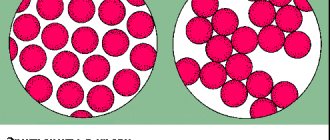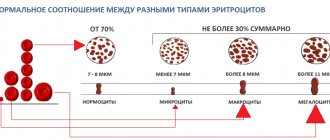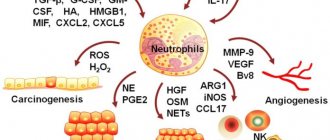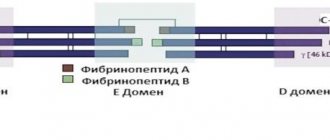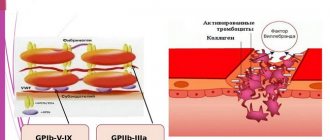Detailed description of the study
The formed elements of human blood - red blood cells - may have some markers on their surface, called antigens.
There are two main such antigens - A and B. Based on their presence, 4 blood groups are distinguished: O(I) - absence of antigens A and B on the surface of the cell A(II) - antigen A is present on the surface of the erythrocyte B(III) - present on the surface of the erythrocyte antigen B AB (IV) - both antigens are found on the surface of the erythrocyte
These antigens have no physiological role, but determine the compatibility of blood during transfusion. When incompatible blood is transfused, an immune reaction of rejection of the foreign protein develops, which leads to the destruction of red blood cells - hemolysis.
Another marker of blood compatibility during transfusion is the Rh factor. This is a protein that is produced in 85% of Caucasians and 99% of people of the Mongoloid race. It is present on the surface of red blood cells, but does not play a significant role in the life of the body.
When blood containing the Rh factor enters the bloodstream of a person who does not have this protein on the surface of red blood cells, the human immune system perceives it as foreign. As a result, hemolysis develops. Therefore, blood transfusion requires taking into account compatibility not only by blood group, but also by the Rh factor.
It is especially important to know your Rh status for women planning a pregnancy. If a woman with no Rh factor becomes pregnant with an Rh positive man, there is a chance that the child will also have an Rh factor.
In such a case, antibodies to the Rh factor may appear in the mother, which will cause hemolysis of the fetus, which is called Rh conflict. The formation of these antibodies can occur when fetal blood enters the mother's bloodstream. Factors that increase the risk of Rh conflict are:
- Complications of a previous pregnancy in the early stages (ectopic pregnancy or its termination);
- Abdominal injury during pregnancy;
- Vaginal bleeding during pregnancy;
- Medical interventions during pregnancy that require the removal of cells or fluid from the amniotic sac, such as amniocentesis and chorionic villus sampling.
With increasing gestational age, the risk of developing Rh conflict increases. Its appearance in the first trimester leads to missed pregnancy and its early loss; in the case of late Rh conflict, premature birth is possible. The newborn has hemolytic jaundice, which is accompanied by damage to internal organs and requires treatment.
It is important that antibodies to the Rh factor take time to form. Often the first pregnancy with Rh conflict proceeds favorably, since the immune system is just beginning to produce antibodies. The risk of complications in the second and subsequent pregnancies is much higher.
Studying your blood group and Rh factor helps you avoid complications associated with blood transfusions. With regard to the Rh factor, its determination is also important for assessing the risk of Rh conflict during pregnancy.
Why is it important to know your blood type?
Determining blood group compatibility is necessary, first of all, for transfusion (blood transfusion). Large blood loss is deadly. Since ancient times, attempts have been made to compensate for blood loss by infusing the blood of another person. But the first blood you come across cannot be used. When mixing blood “blindly,” in about half of the cases, agglutination occurs: red blood cells (erythrocytes) begin to stick together, forming clumps. The flakes resulting from agglutination are visible in a test tube with the naked eye; it is clear that if this process happens inside the circulatory system, nothing good can be expected for a person.
Agglutination
At the beginning of the 20th century, it was established why agglutination occurs. On the surface of the erythrocyte (red blood cell) membrane there are special antigen proteins (they are called agglutinogens). They are called antigens because they can bind to other substances - antibodies. This connection is specific, that is, a given antigen can only be bound by a specific antibody. When we talk about blood groups, we use a system that is only interested in two antigens (in fact, there are many more of them “riding” on red blood cells). For convenience, these antigens (agglutinogens) are designated by the first letters of the Latin alphabet - A and B. The corresponding antibodies (they are called agglutinins) are designated by the first letters of the Greek alphabet - α (alpha) and β (beta).
Obviously, an antigen and its corresponding antibody cannot be present in the blood at the same time, otherwise a reaction (agglutination) would occur. But other combinations are possible. They are the ones who determine which group our blood belongs to.
What documents contain this information?
Many people have no idea where their blood type is written. The first document in which health information is stored is certificates received at birth. All newborns must have a health card. This medical document contains the Apgar score the baby receives at birth, blood notes, weight, height, and the results of specialist examinations. Parents are strongly advised to keep the card, for example, to redirect from one clinic to another when moving.
This information can be included in an insurance certificate, military ID, or even a passport. However, it often happens that a child’s card is lost, and you need to find out the blood characteristics.
How to balance your diet
The diet for blood group 3 is aimed at preventing possible diseases. It takes into account products in terms of benefits and degrees of harm.
People with group No. 3 can practically tolerate any food well, because they are maximally protected. However, there is a certain balance in nutrition, preference for certain types of foods. It can be expressed by dividing possible products into three groups.
Which is definitely useful
Lamb, poultry, and rabbit are recommended; among fish, halibut, salmon, sturgeon, flounder, sardine, cod, and pike are preferred.
Dairy products from skim milk, goat milk, Mozzarella cheese, olive vegetable oil, mayonnaise, mustard. The only nuts offered are walnuts and almonds. Legumes are red. Porridge made from oatmeal, rice, millet. White bread.
Vegetables, fruits: beets, carrots, eggplants, cabbage, parsley, parsnips, bananas, grapes, pineapple, ginger. You can drink green tea.
Allowed temporarily
Meat products from beef, turkey, liver. Fish: carp, herring, squid. Butter, hard cheeses, flaxseed oil. Legumes - green peas. Rye bread. Drinking white or red wine, black tea and coffee is rarely possible.
Vegetables, fruits: potatoes, cucumbers, green onions, garlic, pumpkin, spinach, oranges, watermelon, pears, cherries, currants, figs, raisins, prunes, peaches, apples, lemon.
If you decide to eat according to your blood type, you just have to look at some foods
Not recommended
Eastern recommendations are against chicken, goose, duck, ham, pork, and heart dishes. Perch, crayfish, smoked salmon, shellfish, processed cheese, ice cream, sunflower and corn oil, ketchup, seeds, peanuts, lentils, buckwheat, millet and barley porridge, and baked goods are contraindicated.
Vegetables, fruits: tomatoes, radishes, corn, pomegranate, rhubarb, persimmon. Alkaline mineral waters, strong alcohol.
Basic concept of Rh factor
The specificity of any organism is determined by a set of proteins or antigens that are part of any tissue. In relation to blood and its red blood cells, these are their surface antigenic complexes. One of them is the Rh factor or Rh antigen. Depending on its presence, all people are divided into Rh-positive (carriers of the antigen) and Rh-negative (people who do not have the Rh antigen). All life situations that involve the need to mix the blood of different people are determined by the ability of the blood not to disrupt its structure after such a procedure. This largely depends on Rh compatibility.
Important to remember! Compatible blood according to the Rh factor system is that which will be perceived by the body as its own. This means that only blood identical in Rh factor can be so!
When can immunoglobulin prophylaxis be carried out?
To prevent conflict in subsequent pregnancies, women with a negative Rh factor should undergo prophylaxis. This is done after:
- childbirth (within three days);
- abortion;
- analysis of amniotic fluid;
- spontaneous miscarriage;
- ectopic pregnancy;
- placental abruption;
- transfusion.
Remember: if you and your baby’s group and Rh are different, this is not an indication that there will definitely be problems. Group and Rh are just the presence or absence of specific proteins in the blood. The reaction of the body and the development of pathologies in our time can be successfully controlled with the help of medications. Your attentiveness to your body, as well as an experienced doctor, will help you bear a healthy baby.
Blood groups and their compatibility
In domestic medicine, groups are designated by a number and called accordingly: first, second, third, fourth. Abroad, this system is called AB0 and the corresponding designations are used.
Group I
(group 0) – first (or zero). People with blood of this group do not have both agglutinogens (A and B) on the erythrocyte membrane, but agglutinins α and β are present in the plasma.
Group II
(A) – second group. The blood of this group contains agglutinogen A and agglutinin β.
Group III
(B) – third group. In the blood, agglutinogen B is present on erythrocytes, and agglutinin α is present in the plasma.
Group IV
(AB) – fourth group. Both antigens are present on red blood cells, but there are no antibodies in plasma.
Whole blood can be transfused only when the blood of both the donor and recipient belongs to the same group. Red blood cells can also be used for transfusion (they are separated from the plasma), in which case only agglutinogens are important. Red blood cells of a person of the first blood group can be transfused to everyone, since they cannot introduce antigen and provoke agglutination. Therefore, a person with the first blood group is a universal donor.
Red blood cells of the second group can be transfused to people who already have agglutinogen A in their blood - that is, with the second and fourth groups. Accordingly, red blood cells of the third group can be transfused to those who have agglutinogen B in their blood; these are the third and fourth groups.
A person with blood type IV is a universal recipient: he can receive red blood cells from people with any blood type, while his blood can only be used for transfusion to people with the same blood type.
What are zoliclones?
Tsoliklon is a saline solution of monoclonal antigens to human erythrocyte antibodies. Monoclonal antibodies are used to determine blood group. To obtain them, hybridoma technology is used. Anti-A and anti-B zoliclones were created to determine human blood groups of the ABO system instead of standard isohem agglutinating sera.
Coliclones anti-A and anti-B are hybridoma products of cell lines acquired as a result of the fusion of mouse antibody-producing B lymphocytes with mouse tumor cells (bone marrow myeloma). Personal hybridomas produce bands of homogeneous antibodies only of the 1st class, which, immunoglobulins, are entirely similar in structure and bio Antibodies. The activities produced by cells of the 1st clone (offspring of one cell) are monoclonal.
In antibodies, cells of the same specificity, originating from the 1st form, lymphocyte cells of the 1st clone. The main thing is that you need to: then get special antibodies from one cell and develop them in huge quantities. The difficulty lies in overcoming two tasks: firstly, ordinary cells die after several divisions; secondly, only cancer cells are capable of multiplying indefinitely. To solve these two incomparable problems, G. Köhler and K. Milstein made cell modifications or hybridomas in 1975. Hybridomas are the fusion of ordinary lymphocytes in a nutrient medium with lymphocyte cells. myelomas do not die in this environment, and from the myeloma they receive a partner the opportunity to endlessly reproduce. In a similar hybridoma way, the clan multiplies, and as a result of this process, monoclonal antibodies are formed.
What should you consider when conducting your analysis?
In order for the analysis result to be as reliable as possible, a number of conditions must be met during the procedure:
- reagents should be stored in a cool place at a temperature of +2-8 degrees in bottles with a tightly screwed cap (if storage rules are violated, they quickly lose their properties);
- For analysis, you cannot use cyclones that have expired (about 30 days) or liquids that contain sediment, flakes or debris;
- the study is performed in a well-lit room at an air temperature of no lower than +15 and no higher than +25 degrees, and there should be no dirt, dust or other factors that can distort the result;
- when applying biomaterial and reagents to the surface of the tablet, the proportions must be strictly observed - if there is too much blood, the reaction is more difficult to track, and in the opposite case (with a small volume) it will be too slow;
- Drops of blood mixed with different types of zoliclones should not be allowed to merge together - if this happens, the test is carried out again; for the same reason, different sticks should be used to mix reagents with biomaterial.
The reaction duration should be at least 3 minutes, and if the result is questionable, the observation time for biomaterial samples should be extended to 5 minutes. However, after 10 minutes, the biomaterial may dry out and red blood cells may naturally precipitate, so you should not trust such a study.
What diseases does blood predict?
Nature has provided those with the third blood group with good immunity for survival in any conditions. A higher fertility of women has been established compared to other groups. The highest concentration of sex hormones is found in the body of women and men.
There are risk factors for development:
- spinal osteochondrosis;
- intestinal tumors;
- inflammation of the lung tissue;
- urinary system infections;
- septic postpartum complications for women;
- chronic fatigue;
- depressive states;
- autoimmune processes.

